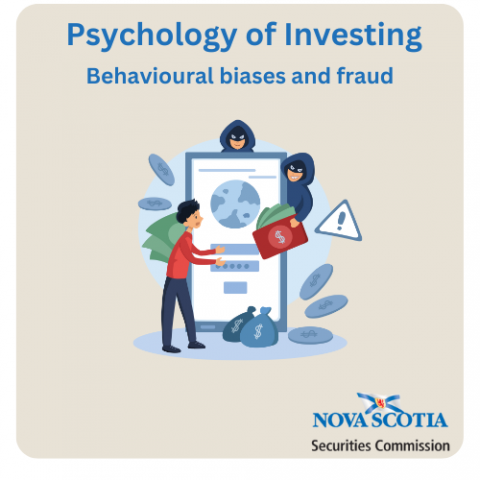Submitted by nsscadmin on

Our psychology of investing series concludes today with a look at behavioural biases and fraud. Throughout the series we’ve talked about several different biases and how they can influence your investing habits. Fraudsters will exploit these biases to take advantage of you and separate you from your hard-earned money. Here’s a recap of a few of the biases we’ve previously mentioned and how fraudsters use them against you.
Present bias is when someone shows a preference towards short-term rewards over long-term rewards, sometimes at the expense the long-term. Someone influenced by present bias could be tempted by a fraudster offering a get-rich-quick scheme that they guarantee will deliver larger returns in a short amount of time.
Due to confirmation bias people will often seek out information that confirms their existing beliefs. By doing some research on their target to determine their beliefs and views, fraudsters can exploit someone influenced by confirmation bias by providing them with information that aligns with these beliefs and views. This can make them more likely to trust the fraudster and accept their fraudulent investment offer.
Anchoring is the tendency for people to rely too heavily on the first piece of information they receive regarding a topic, situation, or decision. Fraudsters can prey on someone that is influenced by anchoring by presenting an inflated initial investment offer. They then follow up with a more reasonable offer. The target could become anchored to the first offer which makes them belief the second offer is more reasonable and worth pursuing.
The pain of loss is often stronger than the pleasure of winning. For those influenced by loss aversion this can lead to extreme feelings of loss, often to their detriment. Fraudsters can target loss aversion by creating a strong sense of urgency to invest and a fear of missing out, or losing out on a can’t miss, big-money investment. This desire to avoid losing out can cause someone suffering with loss aversion to invest quickly without taking the time to really consider what they’re doing.
Overconfidence bias occurs when someone is excessively confident in their abilities and/or the decisions they are making. Fraudsters can target overconfident people by presenting investment offers that seem too good to be true but can appeal to their overconfidence making them believe they can’t lose.
To avoid falling victim to investment fraud due to any of the behavioural biases we’ve mentioned, here are some ways to protect yourself.
Seek out a second opinion:
If someone offers you an investment opportunity talk it over with a trusted second source. Have they spotted any red flags you may have missed? Is it too good to be true?
Check registration:
Anyone selling investments must be registered with their provincial securities regulators, which in Nova Scotia means they must be registered with NSSC. You can easily check registration by using the National Registration Search Database.
Take your time:
Never rush into an investment. Always take your time and ask questions. Make sure you know exactly what you’re getting yourself into and have enough information to be comfortable with your decision. It’s ok if your final decision is to not invest.
